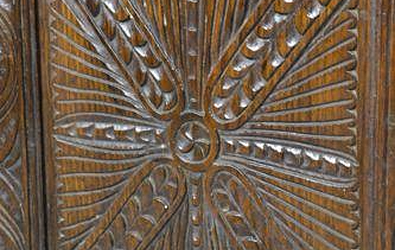Antique oak coffers were often locally made, of simple construction, but of huge importance to their owners. Brilliant pieces of storage furniture throughout the house, we take a look at them in this article.
Antique coffers were often constructed using the hardwood, oak (Latin name: Quercus). Being the principal timber of Britain, it was readily available in large quantities and prized for it's robust qualities. English vernacular furniture was often constructed using oak, and was designed based on local needs and styles. Before modern farming took over, oak forests covered much of England. The largest oak forests were cut down in the 18th Century to build for the Royal Navy [1]. Oak is sturdy and reliable, which makes it ideal for the original use of antique oak coffers as storage furniture.

Some coffers would be heavily carved and decorated.

Geometric carvings were popular.
In the first half of the 17th century, people lived simply and personal possessions were few and far between. What possessions they did own, were important to their owners and they wanted to look after them. This is where coffers came in. Local joiners were commissioned to make various pieces of storage furniture. They were general purpose items, as well as being used for storage, some would be used for seating and occasionally for sleeping on. It would be common for each adult to have their own coffer, and sometimes children would be lucky enough to have their own. Wealthy nobles would eventually own hundreds upon hundreds of chests, as shown by wills and death-rolls [2]. A coffer was ' a chest of importance' [3].
One common example, was the six board or six plank coffer. They were constructed simply. This common household chest was made using six flat planks. Five of the boards are used to construct the end, sides and bottom, and the last plank is used to make the lid. The end board is often longer to raise the coffer off the ground. Often these are reinforced on the corner joints by using metal straps. The simplicity of this design led to it remaining in common use from the 9th century into the 17th century. Carvings or paintings were used to decorate the chests but they were also beautiful when left fairly simple and undecorated.
Perhaps our favourite thing about Antique Coffers is the value for money when owning a very old, antique piece of furniture. There aren't many pieces of furniture that you could own that may date back from the 17th Century, that could be bought for a few hundred pounds. Add to that the fact that they are hugely practical and functional.
The Victorians often carved into plain 17th century coffers to make them more elaborate pieces of furniture in their homes, and you can also find ebonised coffers. In the 19th and 20th centuries, the mule chest with two drawers became more popular. The drawers were handy for shoes and small items of clothing, while the rest could be used for blankets, linens, or clothes.
They are multi-use pieces of furniture, as well as being used as blanket boxes in the bedroom, they are often used as toy storage in children's bedrooms, or playrooms. For those wishing to have something different in their living spaces, they make unusual but practical coffee tables , TV stands and foot rests in living rooms. Who wouldn't want to have historic furniture to admire while they relax with a cup of earl grey or a steaming hot coffee? The places they may have been, what ports have they landed in, and who may have used them? All these questions are worth pondering over on a wet Sunday afternoon! One thing you can be sure of, you won't regret owning such a beautifully made multi purpose piece of history.
- Wikipedia - Oak
- Eames, Penelope, Furniture in England, France and the Netherlands from the Twelfth to the Fifteenth Century (1977)
- Fiske, James, When Oak was New, English Furniture & Daily Life 1530-1700 (2013)
We specialise in good quality 19th and 20th century furniture & have 100s of items for your home and garden in stock now. We regularly stock Ercol, G Plan, Ladderax, mid century, arts & crafts, antique pine, mahogany, solid oak, good quality vintage & antique furniture. We love vintage chairs!






1 comment
I have an oak blanket chest which was a wedding present to my parents in the late 1930 s . It still looks good in my hall and is an attractive and useful piece of furniture . Thank you for your interesting article .